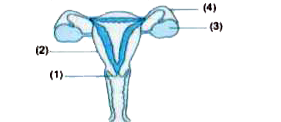Which of the following situations correctly describe the similarity between an angiosperm egg and a human egg ?
(i) Eggs of both are formed only once in a lifetime.
(ii) Both the angiosperm egg and human egg are sttionary.
(iii) Both the angiosperm egg and human egg are motile transported.
(iv) Syngamy in both results in the option given below.
(ii) and (iv)
(iv) and only
(iii) and (iv)
(i) and (iv)
The correct Answer is:B
Step by step video, text & image solution for Which of the following situations correctly describe the similarity between an angiosperm egg and a human egg ? (i) Eggs of both are formed only once in a lifetime. (ii) Both the angiosperm egg and human egg are sttionary. (iii) Both the angiosperm egg and human egg are motile transported. (iv) Syngamy in both results in the option given below. by Biology experts to help you in doubts & scoring excellent marks in Class 12 exams.
Updated on:21/07/2023Topper's Solved these Questions
- PRINCIPLES OF INHERITANCE AND VARIATIONBOOK - ERRORLESS CHAPTER - PRINCIPLES OF INHERITANCE AND VARIATIONEXERCISE - Principles Of Inheritance And Variation
716 Videos
- SEXUAL REPRODUCTIO IN FLOWERING PLANTSBOOK - ERRORLESS CHAPTER - SEXUAL REPRODUCTIO IN FLOWERING PLANTSEXERCISE - Sexual Reproductio In Flowering Plants
322 Videos
Similar Questions
(a) Specify the events which occur in the reproductive system of human female:
(i) If egg is fertilised.
(ii) If egg is not fertilised.
(b) Mention the changes that take place in uterus in both the above events.
View SolutionAnswer question on the basis of your understanding of the following paragraph and the related studied concepts :
(i) When a girl is born, the ovaries already contain thousands of immature eggs
(ii) On reaching puberty, some of these start maturing. One egg is produced every month by one of the ovaries.
(iii) The egg is carried from the ovary to the womb through a thin oviduct or fallopian tube.
(iv) The two oviducts unite into an elastic bag-like structure known as the uterus.
(v) The uterus opens into the vagina through the cervix.

What is the site of fertilisation ?
View Solution
Knowledge Check
Which of the following situations correctly describe the similarity between an angionsperm egg and a lifetime .
i. Egss of both are formed only once in a lifetime.
ii. Both the angiosperm egg and human eggs are stationary .
iii. Both the angiospherm egg and human egg are motile transported.
iv. Syngamy in both results in the formation of zygote.
Choose the correct answer from the options gives below :Aii and ivBiv onlyCiii and ivDiand ivWhich of the following statements is/are correct ?
(i) Endothecium lies below epidermis
(ii) Fusion of egg with male gamete is called apogamy
(iii) Synergids are haploid.
(iv) The point at which funicle touches the ovule is raphe.A(i) and (iv)B(i) and (ii)C(i) and (iii)D(ii) and (iii)Which of the following statements are correct regarding the development of embryo sac ?
(i) The type of nuclear division is free , in which there is no formation of the cell wall .
(ii) Out of the eight nuclei , six are surrounded by a cell wall .
(iii) Central cell situated below the egg apparatus.Ai and ii onlyBii and iii onlyCiii onlyDAll are correct
Answer question on the basis of your understanding of the following paragraph and the related studied concepts :
(i) When a girl is born, the ovaries already contain thousands of immature eggs
(ii) On reaching puberty, some of these start maturing. One egg is produced every month by one of the ovaries.
(iii) The egg is carried from the ovary to the womb through a thin oviduct or fallopian tube.
(iv) The two oviducts unite into an elastic bag-like structure known as the uterus.
(v) The uterus opens into the vagina through the cervix.

How many eggs are produced each month and why ?
View SolutionAnswer question on the basis of your understanding of the following paragraph and the related studied concepts :
(i) When a girl is born, the ovaries already contain thousands of immature eggs
(ii) On reaching puberty, some of these start maturing. One egg is produced every month by one of the ovaries.
(iii) The egg is carried from the ovary to the womb through a thin oviduct or fallopian tube.
(iv) The two oviducts unite into an elastic bag-like structure known as the uterus.
(v) The uterus opens into the vagina through the cervix.

Give suitable terms for starting and ending of reproductive phase in human females.
View SolutionAnswer question on the basis of your understanding of the following paragraph and the related studied concepts :
(i) When a girl is born, the ovaries already contain thousands of immature eggs
(ii) On reaching puberty, some of these start maturing. One egg is produced every month by one of the ovaries.
(iii) The egg is carried from the ovary to the womb through a thin oviduct or fallopian tube.
(iv) The two oviducts unite into an elastic bag-like structure known as the uterus.
(v) The uterus opens into the vagina through the cervix.

Based on the diagram (1 - 4) and statements [(in) - (v)] given above match the information.
View SolutionWhich of the following colloidal sols are prepared by shaking the lyophilic material with dispersion medium?
(i) Gelatin , (ii) Gum
(iii) Starch , (iv) Egg albumin
View SolutionWhich of the following statements is/are incorrect ?
(i) The liver fluke, a parasite, depends on tntermediate hosts (a snail) to complete its life cycle.
(ii) The malarial parasite needs a vector (mosquito) to spread to other host organisms.
(iii) In case of brood parasitism, the eggs of parasitic birds are not detected and removed from the nest because the parasite's eggs resemble the host's eggs in morphology and colour.
(iv) A population of frogs protected from all predators would increase indefinitely.
View Solution
